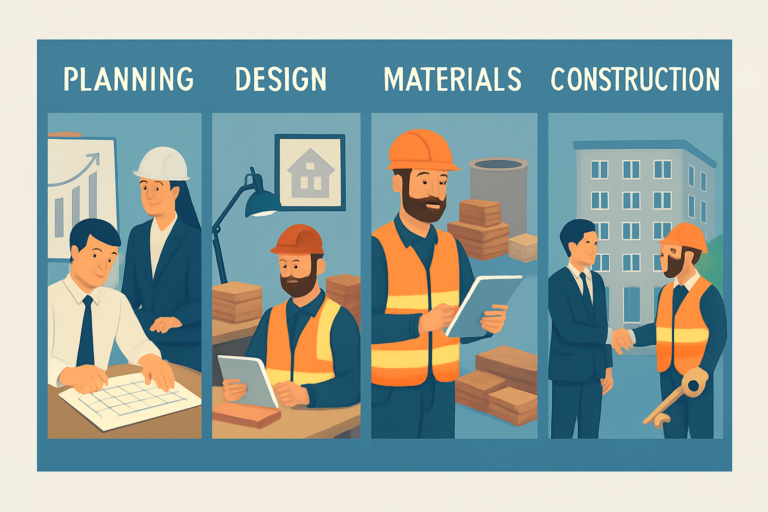Introduction
Construction prices in the UK have been steadily rising. Between higher material costs, labour shortages, and unpredictable supply chains, it’s easy for projects to go over budget. But cutting corners isn’t the answer—poor workmanship or inferior materials can lead to delays, defects and even safety risks down the road.
Here are five proven strategies you can use today to keep your build costs under control and still deliver a high‑quality finished project.
1. Smart Design Up Front
1.1 Use BIM for Better Coordination
Building Information Modelling (BIM) is a digital way to plan your project in 3D before any bricks are laid. With BIM you can:
- Spot clashes (for example, a pipe running through a structural beam)
- Coordinate all trades (architects, structural engineers, M&E designers) in one model
- Reduce on‑site changes and delays
Benefit: Projects that use BIM report up to 20% lower whole‑life costs, thanks to fewer mistakes and smoother hand‑offs.
Learn more on the McKinsey website:
https://www.mckinsey.com/industries/capital-projects-and-infrastructure/our-insights/how-bim-is-transforming-construction
1.2 Apply Value Engineering
Value Engineering (VE) is a team workshop that asks: “Can we meet the same function, but at lower cost?” In practice this might mean:
- Swapping a custom steel detail for a standard steel section
- Choosing a slightly different tile that looks just as good but costs less per m²
- Revising a roof detail so it’s faster to build
Benefit: VE can save 5–15% of your hard construction costs, by cutting waste without cutting quality.
For a step‑by‑step VE guide, see the Constructing Excellence site:
https://constructingexcellence.org.uk/toolkit/value-management
2. Offsite and Modular Construction
2.1 What Is Offsite Construction?
Instead of building everything on your site, you move large chunks into a factory:
- Volumetric modules (fully fitted rooms or pods)
- Panelised systems (walls, floors, roof panels)
These come to site ready to slot together.
2.2 Why It Saves Money
- Factory efficiency: Climate‑controlled, repetitive processes reduce mistakes.
- Less waste: Scrap rates drop because materials stay in a managed environment.
- Faster schedules: Assembly on site can be 20–50% quicker than traditional builds.
Benefit: In the UK, offsite methods can shave weeks or even months off your on‑site programme and cut site running costs (security, site offices, scaffolding).
Read HM Government’s MMC guide here:
https://www.gov.uk/guidance/modern-methods-of-construction
3. Smarter Procurement and Bulk Buying
3.1 Go Digital with Procurement Platforms
A good procurement tool shows you:
- Multiple supplier quotes side by side
- Up‑to‑date stock levels (so you don’t over‑order)
- Historical spend data (to spot your biggest cost drivers)
This transparency helps you negotiate better deals.
3.2 Lock in Framework Agreements
By signing a long‑term deal with a materials supplier you can:
- Fix prices ahead of time (hedging against market spikes)
- Qualify for bulk‑order discounts
- Simplify ordering processes month after month
3.3 Just‑in‑Time Delivery
Coordinate deliveries so materials arrive exactly when you need them:
- Cuts storage costs on site
- Reduces handling damage
- Keeps cash flow healthy (you pay as you build, not months in advance)
Benefit: Digital procurement plus bulk/bundled orders can reduce material spend by up to 10% or more.
Explore one platform example here:
https://www.procore.com
4. Lean Construction: Cut Waste, Boost Efficiency
4.1 What Is Lean Construction?
Originating from car manufacturing, Lean Construction focuses on continuous improvement and waste elimination. The “wastes” include:
- Material waste (leftover stock, off‑cuts)
- Labour waste (crew waiting around)
- Time waste (rework, delays)
4.2 Key Lean Tools for Site
- Early Contractor Involvement (ECI): Get your main trades in during design to flag buildability issues early.
- WIP (Work‑in‑Progress) Limits: Only start what you can finish this week—avoids clutter and bottlenecks.
- Digital QA/QC Checklists: Mobile apps let supervisors raise and close out snags in real time, preventing minor issues from becoming major rework.
Benefit: Projects that adopt Lean can cut total waste by 30%, translating directly into cost savings.
For more on lean methods, visit the Lean Construction Institute:
https://www.leanconstruction.org
5. Invest in People and Quality Control
5.1 Train Your Teams
- Upskilling: Regular workshops on new materials (e.g. high‑performance insulation), tools (e.g. laser levels), and digital systems (e.g. BIM viewers).
- Certifications: Encourage NVQs and CPCS cards so workers meet national quality and safety standards.
5.2 Robust Onboarding
- Clear site induction with safety and quality standards laid out
- Written method statements so every team member knows exactly how work should be done
5.3 Embedded Quality Checks
- Set check‑in points (e.g. slab before screed, framing before cladding)
- Use one digital system for snag lists so nothing slips through the cracks
Benefit: Fixing a defect after handover can cost 3–5× more than addressing it during construction.
A simple QA/QC regime pays for itself in reduced rework.
Putting It All Together: A Sample Workflow
- Month –3 to –2: Design phase
- Kick off BIM coordination
- Run Value Engineering workshops
- Month –2: Procurement
- Issue tender via digital platform
- Award main supply contracts and lock in framework rates
- Month –1: Offsite manufacture
- Begin modular unit fabrication
- Schedule just‑in‑time delivery slots
- Construction phase:
- Use ECI to resolve any buildability queries
- Apply Lean WIP limits to each trade package
- Conduct weekly QC sign‑offs via mobile app
- Handover:
- Final snag list closed out
- As‑built BIM model delivered to client
By weaving these five strategies into your process, you’ll not only protect your bottom line but also deliver a high‑quality, on‑time project your clients will love.
Further Reading & Tools
- BIM Basics – McKinsey: https://www.mckinsey.com/industries/capital-projects-and-infrastructure/our-insights/how-bim-is-transforming-construction
- Modern Methods of Construction – UK Gov: https://www.gov.uk/guidance/modern-methods-of-construction
- Value Management – Constructing Excellence: https://constructingexcellence.org.uk/toolkit/value-management
- Lean Construction Institute: https://www.leanconstruction.org
- Digital Procurement Platform – Procore: https://www.procore.com


